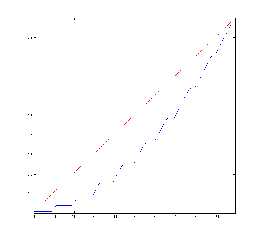|
 |
On 8-2-2010 20:04, Orchid XP v8 wrote:
> Warp wrote:
>
>> However, suppose that you use a variant of this: Throw two d10's and
>> then the larger result is always used as the tens, and the other as the
>> ones.
>>
>> What is the probability distribution now?
>
> Pr(0) = 1/100
> Pr(1) = 0/100
> Pr(2) = 0/100
> Pr(3) = 0/100
> Pr(4) = 0/100
> Pr(5) = 0/100
> Pr(6) = 0/100
> Pr(7) = 0/100
> Pr(8) = 0/100
> Pr(9) = 0/100
> Pr(10) = 2/100
> Pr(11) = 1/100
> Pr(12) = 0/100
> Pr(13) = 0/100
> Pr(14) = 0/100
> Pr(15) = 0/100
> Pr(16) = 0/100
> Pr(17) = 0/100
> Pr(18) = 0/100
> Pr(19) = 0/100
> Pr(20) = 2/100
> Pr(21) = 2/100
> Pr(22) = 1/100
> Pr(23) = 0/100
> Pr(24) = 0/100
> Pr(25) = 0/100
> Pr(26) = 0/100
> Pr(27) = 0/100
> Pr(28) = 0/100
> Pr(29) = 0/100
> Pr(30) = 2/100
> Pr(31) = 2/100
> Pr(32) = 2/100
> Pr(33) = 1/100
> Pr(34) = 0/100
> Pr(35) = 0/100
> Pr(36) = 0/100
> Pr(37) = 0/100
> Pr(38) = 0/100
> Pr(39) = 0/100
> Pr(40) = 2/100
> Pr(41) = 2/100
> Pr(42) = 2/100
> Pr(43) = 2/100
> Pr(44) = 1/100
> Pr(45) = 0/100
> Pr(46) = 0/100
> Pr(47) = 0/100
> Pr(48) = 0/100
> Pr(49) = 0/100
> Pr(50) = 2/100
> Pr(51) = 2/100
> Pr(52) = 2/100
> Pr(53) = 2/100
> Pr(54) = 2/100
> Pr(55) = 1/100
> Pr(56) = 0/100
> Pr(57) = 0/100
> Pr(58) = 0/100
> Pr(59) = 0/100
> Pr(60) = 2/100
> Pr(61) = 2/100
> Pr(62) = 2/100
> Pr(63) = 2/100
> Pr(64) = 2/100
> Pr(65) = 2/100
> Pr(66) = 1/100
> Pr(67) = 0/100
> Pr(68) = 0/100
> Pr(69) = 0/100
> Pr(70) = 2/100
> Pr(71) = 2/100
> Pr(72) = 2/100
> Pr(73) = 2/100
> Pr(74) = 2/100
> Pr(75) = 2/100
> Pr(76) = 2/100
> Pr(77) = 1/100
> Pr(78) = 0/100
> Pr(79) = 0/100
> Pr(80) = 2/100
> Pr(81) = 2/100
> Pr(82) = 2/100
> Pr(83) = 2/100
> Pr(84) = 2/100
> Pr(85) = 2/100
> Pr(86) = 2/100
> Pr(87) = 2/100
> Pr(88) = 1/100
> Pr(89) = 0/100
> Pr(90) = 2/100
> Pr(91) = 2/100
> Pr(92) = 2/100
> Pr(93) = 2/100
> Pr(94) = 2/100
> Pr(95) = 2/100
> Pr(96) = 2/100
> Pr(97) = 2/100
> Pr(98) = 2/100
> Pr(99) = 1/100
>
> You can compute this quite easily in Haskell:
>
> numbers = do
> a <- [0..9]
> b <- [0..9]
> let x = max a b
> let y = min a b
> return (10*x + y)
>
> This tries every possible combination of D10 scores, and builds a list
> of the resulting score.
>
> histogram =
> map (\xs -> (head xs, length xs)) $
> group $
> sort numbers
>
> This sorts the above list, groups equal elements into little sublist,
> and then counts the length of all such sublists, producing a histogram
> chart for all scores with non-zero frequency.
>
> With a little extra trickery and some formatting, you can create the
> above chart.
>
Post a reply to this message
Attachments:
Download 'warp.png' (9 KB)
Preview of image 'warp.png'

|
 |




![]()